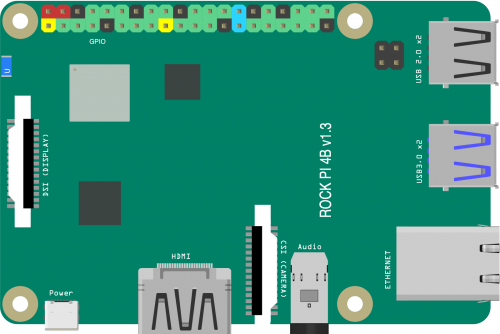Difference between revisions of "Rockpi4"
(→Software) |
(→Introduction) |
||
| Line 12: | Line 12: | ||
== Introduction == | == Introduction == | ||
| − | ROCK Pi 4 is a Rockchip RK3399 based SBC(Single Board Computer) by [[Special:SpecialContact| Radxa]]. It can run android or some Linux distributions. | + | ROCK Pi 4 is a Rockchip RK3399 based SBC(Single Board Computer) by [[Special:SpecialContact/es_es| Radxa]]. It can run android or some Linux distributions. |
ROCK Pi 4 features a six core ARM processor, 64bit dual channel 3200Mb/s LPDDR4, up to 4K@60 HDMI, MIPI DSI, MIPI CSI, 3.5mm jack with mic, 802.11 ac WIFI, Bluetooth 5.0, USB Port, GbE LAN, 40-pin color expansion header, RTC. Also, ROCK Pi 4 supports USB PD and QC powering. | ROCK Pi 4 features a six core ARM processor, 64bit dual channel 3200Mb/s LPDDR4, up to 4K@60 HDMI, MIPI DSI, MIPI CSI, 3.5mm jack with mic, 802.11 ac WIFI, Bluetooth 5.0, USB Port, GbE LAN, 40-pin color expansion header, RTC. Also, ROCK Pi 4 supports USB PD and QC powering. | ||
Revision as of 03:57, 11 November 2018
Introduction
ROCK Pi 4 is a Rockchip RK3399 based SBC(Single Board Computer) by Radxa. It can run android or some Linux distributions. ROCK Pi 4 features a six core ARM processor, 64bit dual channel 3200Mb/s LPDDR4, up to 4K@60 HDMI, MIPI DSI, MIPI CSI, 3.5mm jack with mic, 802.11 ac WIFI, Bluetooth 5.0, USB Port, GbE LAN, 40-pin color expansion header, RTC. Also, ROCK Pi 4 supports USB PD and QC powering.
ROCK Pi 4 comes in two models, Model A and Model B, each model has 1GB, 2GB or 4GB ram options. for detailed difference of Model A and Model B, please check Specifications.
Getting started
Refer the ROCK Pi 4 getting started page for how to start with ROCK Pi.
Refer Installation for how to install images on ROCK Pi.
Software
Build
Release Images
Work With ROCKPI4Debian
Work With ROCKPI4Android
Hardware
Blog post from Radxa Team introducing the ROCK Pi hardware design
Refer ROCK Pi 4 Hardware page for detailed info about ROCK Pi.
Quick Lookup
40 PIN header
| Function3 | Function2 | Function1 | GPIO | Pin# | Pin# | GPIO | Function1 | Function2 | Function3 | |
|---|---|---|---|---|---|---|---|---|---|---|
| +3.3V | 1 | 2 | +5.0V | |||||||
| CIF_D7 | VOP_D7 | I2C7_SDA | GPIO2_A7 | 3 | 4 | +5.0V | ||||
| CIF_VSYNC | VOP_CLK | I2C7_SCL | GPIO2_B0 | 5 | 6 | GND | ||||
| CIF_CLKOUT | VPO_DEN | SPI2_CLK | GPIO2_B3 | 7 | 8 | GPIO4_C4 | DEBUG_TXD | |||
| GND | 9 | 10 | GPIO4_C3 | DEBUG_RXD | ||||||
| VOP1_PWM | VPO0_PWM | PWM0 | GPIO4_C2 | 11 | 12 | GPIO4_A3 | I2S1_SCLK | |||
| PWM1 | GPIO4_C6 | 13 | 14 | GND | ||||||
| SPDIF_TX | GPIO4_C5 | 15 | 16 | GPIO4_D2 | ||||||
| +3.3V | 17 | 18 | GPIO4_D4 | |||||||
| UART4_TXD | SPI1_TXD | GPIO1_B0 | 19 | 20 | GND | |||||
| UART4_RXD | SPI1_RXD | GPIO1_A7 | 21 | 22 | GPIO4_D5 | |||||
| PMCU_JTAG_TCK | SPI1_CLK | GPIO1_B1 | 23 | 24 | GPIO1_B2 | SPI1_CSn | PMCU_JTAG_TMS | |||
| GND | 25 | 26 | ADC_IN0 | |||||||
| CIF_D0 | VOP_D0 | I2C2_SDA | GPIO2_A0 | 27 | 28 | GPIO2_A1 | I2C2_CLK | VOP_D1 | CIF_D1 | |
| CIF_CLKIN | I2C6_SCL | SPI2_TXD | GPIO2_B2 | 29 | 30 | GND | ||||
| CIF_HREF | I2C6_SDA | SPI2_RXD | GPIO2_B1 | 31 | 32 | GPIO3_C0 | SPDIF_TX | MAC_COL | UART3_CTSn | |
| SPI2_CSn | GPIO2_B4 | 33 | 34 | GND | ||||||
| I2S1_LRCK_TX | GPIO4_A5 | 35 | 36 | GPIO4_A4 | I2S1_LRCK_RX | |||||
| GPIO4_D6 | 37 | 38 | GPIO4_A6 | I2S1_SDI | ||||||
| GND | 39 | 40 | GPIO4_A7 | I2S1_SDO |
Community
- Forum: http://forum.radxa.com
- Telegram Group: https://t.me/rockpi4

